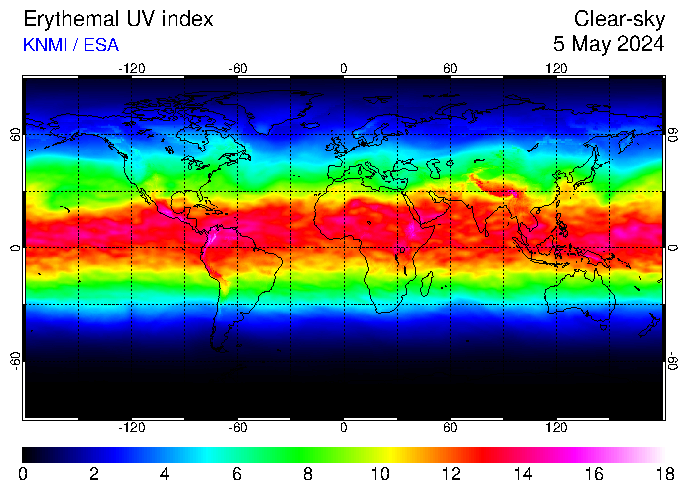 ISO 24444 / ISO 24443
ISO 24444 / ISO 24443 EU COLIPA and SANS 1557 Verified Broadspectrum Sunscreens

The Global UV Index provides a worldwide view of ultraviolet radiation levels across different regions and countries. This map helps travellers, outdoor enthusiasts, and health professionals understand UV exposure risks around the globe and plan appropriate sun protection strategies.

The worldwide UV index reveals important geographical patterns in sun intensity. Unlike temperature, which varies seasonally in predictable ways, UV levels are influenced by multiple factors including latitude, altitude, ozone concentration, and environmental conditions.
It's important to note that this global map shows general patterns and does not account for local weather conditions such as cloud cover. While clouds can reduce UV-B radiation, they allow significant UV-A radiation to penetrate, meaning proper sun protection is essential even on overcast days.
UV levels in the Northern Hemisphere follow a predictable seasonal pattern, with highest intensity from May to August. Countries near the equator (such as Mexico, northern Africa, and Southeast Asia) experience consistently high UV levels year-round.
Northern European countries experience dramatic seasonal UV variations, with very low levels in winter months and moderate to high levels during summer.
The Southern Hemisphere (including South Africa, Australia, New Zealand, and South America) typically experiences its highest UV levels from November to February. Due to reduced ozone protection and Earth's orbital characteristics, summer UV levels in the Southern Hemisphere can be up to 10% higher than equivalent Northern Hemisphere locations.
Australia and New Zealand regularly record some of the world's highest UV readings, with extreme levels (11+) common during summer months.
Countries near the equator (between 23.5°N and 23.5°S) experience consistently high UV levels throughout the year with minimal seasonal variation. These regions include parts of Central Africa, Southeast Asia, and northern South America.
At high altitudes in equatorial regions (like the Andes Mountains or East African highlands), UV levels can reach extreme levels year-round due to the combined effects of proximity to the equator and reduced atmospheric protection at elevation.
Several factors affect UV intensity worldwide:
When traveling internationally, it's important to consider the destination's UV levels, which may differ significantly from what you're accustomed to at home. South Africans traveling to high-latitude countries in their summer may experience surprisingly intense UV levels despite relatively mild temperatures, while visitors to South Africa may underestimate our exceptionally high UV intensity.
For detailed information on regional sun protection recommendations and UV-level-specific guidelines, please visit our South African UV Index page, which provides comprehensive protection measures based on UV intensity.
Our team can help you select the right UV protection products for your international travel destinations.
Contact Us